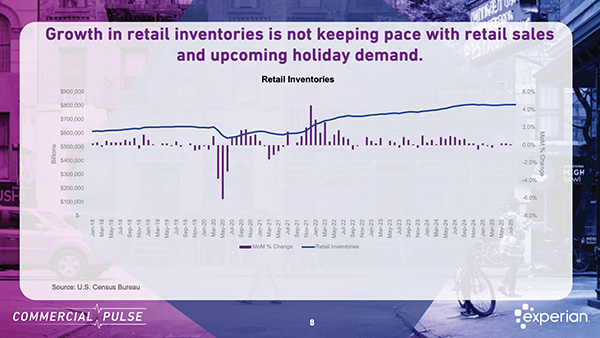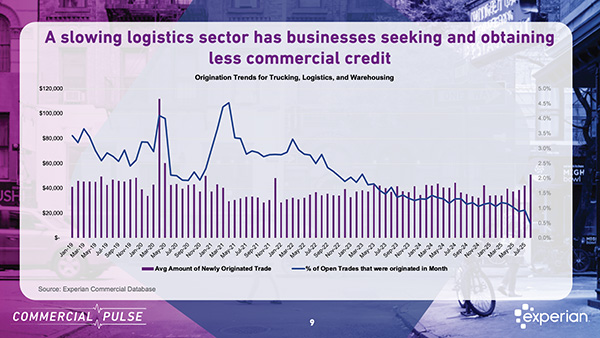Commercial Pulse Report | 7/1/2025
This week the Experian Commercial Pulse report focuses in on a fascinating paradox in the e-commerce industry that credit and risk management professionals should closely monitor. While online retail revenues continue their upward trajectory—now representing over 16% of total U.S. retail sales and generating quarterly revenues exceeding $300 billion—commercial credit inquiries from e-commerce businesses have declined by nearly 25% in the past year alone.
This counterintuitive trend reveals important insights about business maturation, cash flow management, and evolving credit risk profiles in the digital commerce space. Watch our Commercial Pulse update to hear the details.
Market Consolidation in Action
The e-commerce landscape is undergoing significant consolidation. Despite the U.S. hosting nearly 14 million of the world’s 30+ million e-commerce websites, the total number of e-commerce businesses declined by 13.1% between 2024 and 2025. This contraction, following explosive growth during the pandemic years, suggests the sector is moving beyond its initial growth phase into a more mature, efficiency-focused stage.
For credit professionals, this consolidation presents both opportunities and challenges. Fewer new entrants mean reduced origination volumes, but surviving businesses may represent stronger, more creditworthy prospects.
The Credit Demand Decline: Key Metrics
The data reveals several critical trends in e-commerce credit behavior:
Credit Inquiry Patterns:
- 2023 to 2024: 24.9% decrease in commercial credit inquiries
- Average credit accounts per business: Just over 2 accounts
- Average new credit amount: $32,000 (below pre-pandemic levels of $37,000)
Historical Context:
The current average credit amount represents a significant decline from the 2020 peak of $41,000, when federal COVID relief programs supplemented traditional lending. This normalization suggests businesses are operating with more realistic capital requirements and improved cash management.
Strong Credit Performance Indicators
Despite reduced credit demand, e-commerce businesses are demonstrating exceptional credit management:
Delinquency Improvements:
- 60-day past-due rates: Decreased by 50% over four years (from 0.46% to 0.23%)
- 90-day delinquency rates: Following similar downward trend
- Commercial credit scores: Now above pre-pandemic levels
Utilization Efficiency:
- Current utilization rate: 39% (down from 43.5% in 2020)
- Trend indicates improved cash flow management and conservative credit usage
Strategic Implications for Credit Professionals
1. Portfolio Quality Enhancement
The improving delinquency rates and lower utilization suggest that e-commerce businesses requesting credit today may represent higher-quality prospects than in previous years. This sector’s financial discipline could make it an attractive target for lenders seeking low-risk commercial accounts.
2. Origination Strategy Adjustment
With credit inquiries down significantly, lenders may need to be more proactive in their e-commerce outreach. The reduced inquiry volume doesn’t necessarily indicate reduced creditworthiness—it may simply reflect better cash management by these businesses.
3. Risk Modeling Considerations
The sector’s improved risk profile suggests that traditional risk models may need recalibration. E-commerce businesses that weathered the post-pandemic consolidation may deserve more favorable risk assessments than historical data might suggest.
4. Competitive Positioning
As fewer lenders may be focusing on this sector due to reduced demand, there could be opportunities for institutions willing to develop specialized e-commerce credit products and expertise.
Market Outlook and Uncertainties
While the e-commerce sector shows strong fundamentals, broader economic uncertainties remain, including:
- Potential tariff impacts on international supply chains
- Federal Reserve interest rate policy decisions
- Global energy market volatility
These factors could influence future credit demand and risk profiles across all sectors, including e-commerce.
The key takeaway: declining credit demand in e-commerce doesn’t signal sector weakness—it indicates strength. Businesses that have survived the consolidation phase while maintaining strong cash flows and excellent credit performance may represent some of the most attractive commercial credit prospects in today’s market.
Stay Ahead with Experian
- ✔ Visit our Commercial Insights Hub for in-depth reports and expert analysis.
- ✔ Subscribe to our YouTube channel for regular updates on small business trends.
- ✔ Connect with your Experian account team to explore how data-driven insights can help your business grow.



